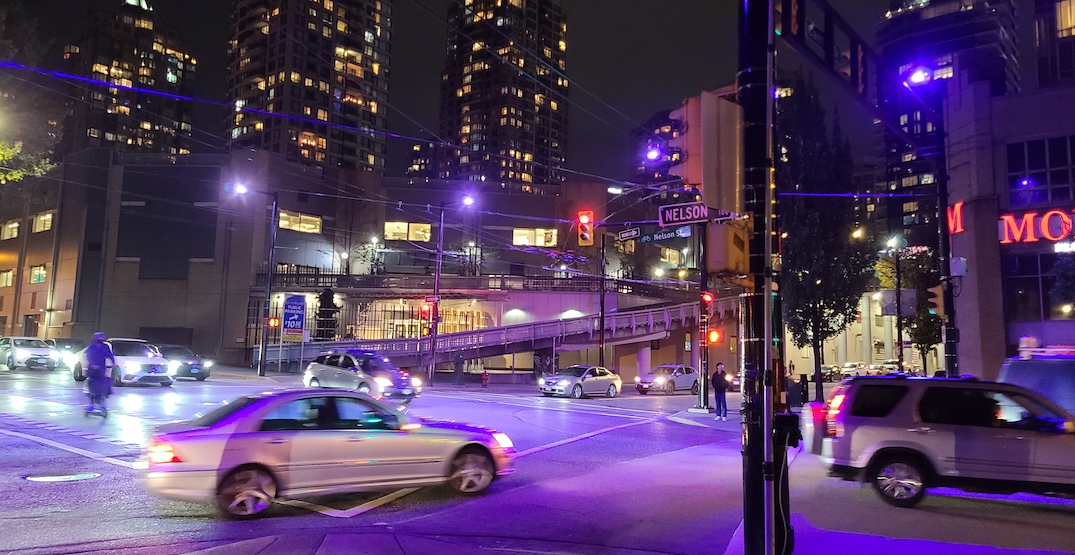This is why some white LED streetlights are starting to turn purple

For years, several Metro Vancouver municipalities have been transitioning their streetlights to LED lighting to improve nighttime visibility, and reduce energy use and cost. But recently, a growing number of white-coloured LEDs have very noticeably taken on a deep purple glow.
The transition from a hue of white to purple does not happen overnight, but rather it is gradual. The phenomenon has also been widely reported in other jurisdictions across Canada and the United States.
And it turns out this is certainly not intentional, but rather a defect of the LED streetlights. The City of Vancouver is amongst the adopters of LED streetlights, and it is also attributing its purple streetlights to a failure of the coating.Read More : Lighting best practices serve up a CEA event appetizer Fortunately, the defective LED streetlights are under warranty by the manufacturer at no cost to the municipal government. “The manufacturer has also completed a root cause analysis of the failure and has taken steps in their manufacturing process to ensure this will not happen again,” the City of Vancouver told Daily Hive Urbanized in an email, encouraging the public to report defective streetlights through the City’s 311 hotline.
“There is no health risk associated with the unintended colour and the City is working with the manufacturer to identify and replace all failures.”
The white-coloured light emitted from LEDs shows surface colours more accurately to the human eye compared to the orange-coloured amber glow of high-pressure sodium luminaires (HPS) being gradually phased out.
LED street lights installed at 125 signal-controlled intersections in Vancouver in recent years are credited for reducing collisions at the intersections by 21% and reducing traffic-related fatalities and injuries involving pedestrians by 65%.
As well, studies show cities that have completed a transition to LEDs see a 50% reduction in electricity costs for their streetlights, plus “substantial” greenhouse gas emission reductions. A transition of Vancouver’s streetlights to LED is estimated to reduce carbon emissions by about 200 metric tonnes of carbon dioxide annually.
Additionally, LEDs have an exponentially longer lifespan and greater reliability than HPS, resulting in lower maintenance and replacement costs, especially with City labour being a major cost.
The transition from a hue of white to purple does not happen overnight, but rather it is gradual. The phenomenon has also been widely reported in other jurisdictions across Canada and the United States.
And it turns out this is certainly not intentional, but rather a defect of the LED streetlights. The City of Vancouver is amongst the adopters of LED streetlights, and it is also attributing its purple streetlights to a failure of the coating.
“There is no health risk associated with the unintended colour and the City is working with the manufacturer to identify and replace all failures.”
The white-coloured light emitted from LEDs shows surface colours more accurately to the human eye compared to the orange-coloured amber glow of high-pressure sodium luminaires (HPS) being gradually phased out.
LED street lights installed at 125 signal-controlled intersections in Vancouver in recent years are credited for reducing collisions at the intersections by 21% and reducing traffic-related fatalities and injuries involving pedestrians by 65%.
As well, studies show cities that have completed a transition to LEDs see a 50% reduction in electricity costs for their streetlights, plus “substantial” greenhouse gas emission reductions. A transition of Vancouver’s streetlights to LED is estimated to reduce carbon emissions by about 200 metric tonnes of carbon dioxide annually.
Additionally, LEDs have an exponentially longer lifespan and greater reliability than HPS, resulting in lower maintenance and replacement costs, especially with City labour being a major cost.
Source: dailyhive.com
